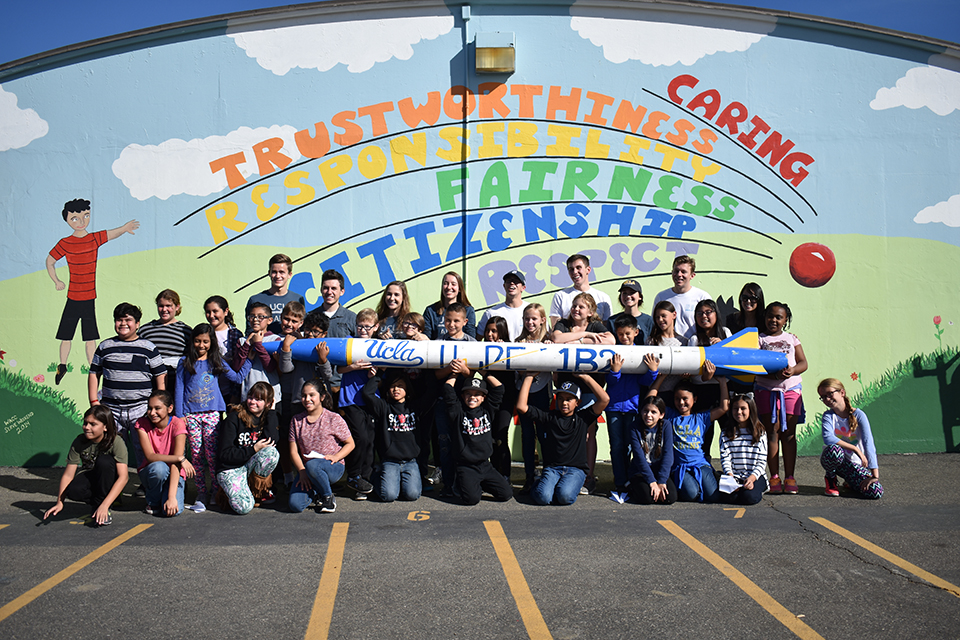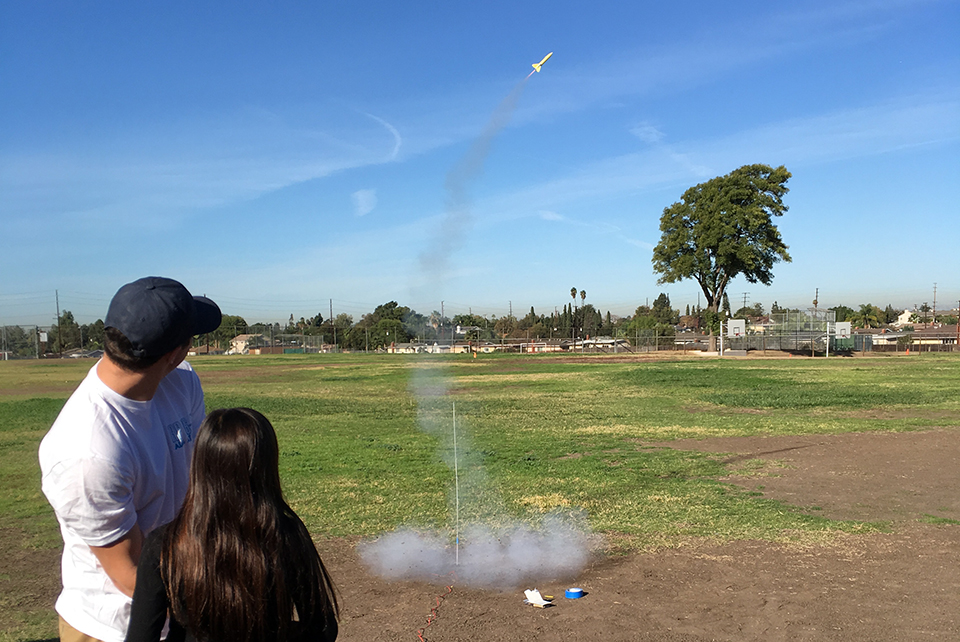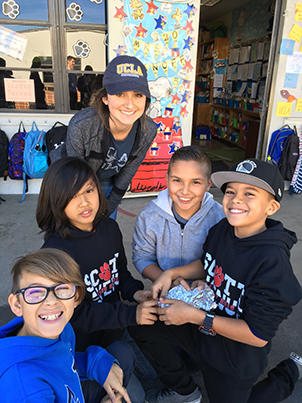
In an effort to promote STEM and inspire young students to become “powerful problem-solvers,” undergraduate members of the Rocket Project at UCLA (URP) recently paid a visit to Scott Avenue Elementary to engage a class of enthusiastic 5th grade students. Through an interactive presentation, a series of hands-on activities, and an exciting rocket launch demonstration, the Rocket Project’s outreach team shared their enthusiasm for engineering and rocketry. In addition to leaving both the elementary schoolers and visiting UCLA students with beaming smiles, this unique event helped teach the importance of team-work and perseverance while simultaneously boosting the STEM-confidence of all involved.
URP Outreach Program is a new initiative for the undergraduate rocket club. Prof. Mitchell Spearrin started it this year to institutionalize outreach activities and make it an essential part of the experience in the rocket club. Spearrin challenged Anil Nair and Caleb Lessard-Clouston early this fall to engage the local community in a more organized and dedicated way and they have done a great job. We are excited to see the reach of our group expand, and to see our students serving as positive examples in the community, connecting with local youth and creating excitement about science, engineering, and rockets.
Led by second-year mechanical engineering student Caleb Lessard-Clouston, members of URP’s outreach team began the day by introducing themselves using their 5th grade portrait photographs. After allowing students to quiz each member on any topic of the class volunteers’ choosing, URP members explained that the day would be all about the exciting possibilities enabled by math and science. The kids were delighted to learn that they were about to take their first college class, Problem Solving 101. URP members questioned the class about how they had solved problems in the past and what kind of challenges they might tackle in the near or distant future. From taking honors classes in middle school, becoming a bio-engineer, training to become a police officer and having to take out the trash when faced with a closed gate, the examples given by the students all demonstrated the necessity of being able to overcome unexpected challenges or obstacles. Upon closing the discussion regarding the frequency and difficulty of such situations and careers, the following four problem-solving elements were discussed and explained:
- Don’t be afraid of the problem
- Allow your mistakes to make you smarter
- Give your full effort
- Work with others
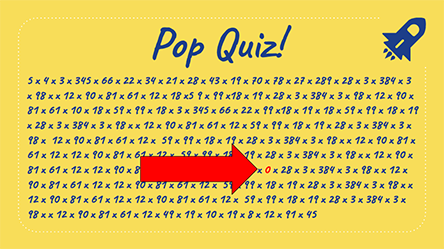 In addition to the student members of the Rocket Project, Dr. Daniel I. Pineda – a URP mentor and Postdoctoral Scholar in the MAE Department – also attended the event. Early into the first portion of the interactive presentation, Dr. Pineda announced a “pop-quiz.” Beginning with “3 x 4” and “4 x 5”, students happily solved simple multiplication problems before reacting to the final question with open-eyed confusion and laughter. Lines and lines of numbers were in the question, all being multiplied by one another. The hidden zeros, which made the whole expression equal to zero, were quickly pointed out to the class to demonstrate that if one is willing to look closely and carefully, there is often a simple solution. Similar interactive questions and opportunities for students to share their thoughts helped reinforced the importance of each problem solving concept.
In addition to the student members of the Rocket Project, Dr. Daniel I. Pineda – a URP mentor and Postdoctoral Scholar in the MAE Department – also attended the event. Early into the first portion of the interactive presentation, Dr. Pineda announced a “pop-quiz.” Beginning with “3 x 4” and “4 x 5”, students happily solved simple multiplication problems before reacting to the final question with open-eyed confusion and laughter. Lines and lines of numbers were in the question, all being multiplied by one another. The hidden zeros, which made the whole expression equal to zero, were quickly pointed out to the class to demonstrate that if one is willing to look closely and carefully, there is often a simple solution. Similar interactive questions and opportunities for students to share their thoughts helped reinforced the importance of each problem solving concept.
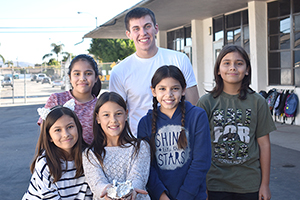
Thanks to the on-campus UCLA Lux Lab run by Doug Daniels, the URP members then brought out 3D-printed rockets, showing them as examples of objects that can only be made by using an iterative design process often riddled with mistakes. After being led to the school’s field and having a volunteer chosen to help with pressing the ignition button, the 3-D printed rocket launched the class into recess. In the words of Alex Lima, one of the URP members who helped facilitate the launch, “Igniting even a single child’s curiosity is more powerful than launching any rocket man can build”. Before recess had even begun, the kids’ smiles and interest had already had translated into thoughts about what was possible and how little was impossible.
Following the end of recess, groups of 5–6 got started on “engineering tasks”. At each of three activity stations, two teams faced off in friendly competition with one another. With only ten minutes to accomplish each task, the three stations challenged students to: (1) use tinfoil to build a boat that could hold the most weight, (2) build the tallest structure possible given only spaghetti and marshmallows, and (3) use their creativity to design and fold a piece of paper into a far-flying plane. No team lacked creativity or confidence, and this hands-on portion was seen by many on URP’s outreach team as the most valuable part of the visit. Caleb Lessard-Clouston summarized, “As important as it is to tell kids that they can and will become powerful problem-solvers, nothing is more important than showing them how capable and intelligent they are. It doesn’t take much effort to remember how amazing it felt when I, as a kid, overcame a problem. Judging by the strength of their high-fives, I would say they were pretty happy too.”
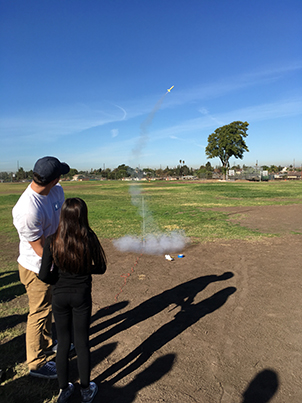
Sophomore aerospace engineering student Anthony Smolyanov also felt that the friendly competition was especially impactful. “Seeing their eyes light up when they realised what would help make their planes fly farthest was absolutely incredible. The more wrong folds a student made, the happier they seemed to be when they corrected their errors and were able to fly their plane.”
Once all the planes had been flown, the students were shown an example of one of the rockets the URP team built for a previous year’s competition. Nora Stacey, a 1st year UCLA student who recently completed the Rocketry Introduction for Student Education (RISE) training program offered by URP, was happy to pass on the knowledge she recently acquired. “My favorite moment was when we brought one of our competition rockets outside and all the kids followed us around asking questions. They were so excited to learn about rocketry and see all of the different pieces of the rocket we had brought with us. I’m pretty sure all of us had smiles on our faces the whole time and I loved getting to know the students and introducing them to engineering-related problem solving”.
With roughly 150 current members, URP is devoted to developing members into future engineering, science and business leaders while producing successful rockets. Engaging the community during outreach events such as this school visit is an important aspect of developing such leaders. The current president of the organization, senior aerospace engineering student Anil Nair, believes the group’s ability to get involved in such events is a reflection of progress made by current and former members. “The project has really come a long way in my four years here. We started out as a small club in a basement and now we are thriving and innovating to benefit of our members, as well as sharing our knowledge and passion for rocketry with local youth. In spreading our enthusiasm for science, I believe we are allowing the next generation of students to see how powerful and approachable engineering really is.”
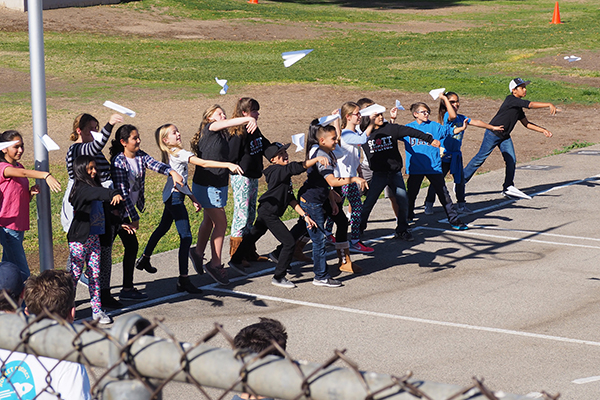
Looking to the next academic term, URP hopes to hold over five school visits, primarily to middle schools in socioeconomically disadvantaged areas in the LA area. In addition, work has already begun on the design of STEM-promoting activity kits that will be given to schools after being visited by the team. Caleb Lessard-Clouston had the following to say regarding the usefulness of such kits: “One of the main issues in education for young children growing up in socioeconomically disadvantaged households is the lack of learning that occurs over breaks from school and outside of the classroom. We believe that following up our visits by giving students a fun project they can work on at home will truly foster students’ creativity and allow students to learn outside of the traditional classroom setting.”
In summarizing the direction and potential impact of the Rocket Project at UCLA’s outreach efforts, Dr. Pineda commented the following, “Space and rocketry are inspiring topics for all ages. With the current aerospace industry experiencing a door-opening paradigm shift, I think it’s critical for us to leverage the enthusiasm of our large and diverse student club into outreach efforts at all levels of pre-collegiate education. By sharing our experiences and genuine enthusiasm regarding the future of innovation and technology, I have no doubt that we will successfully inspire students of all backgrounds to pursue STEM careers.”
